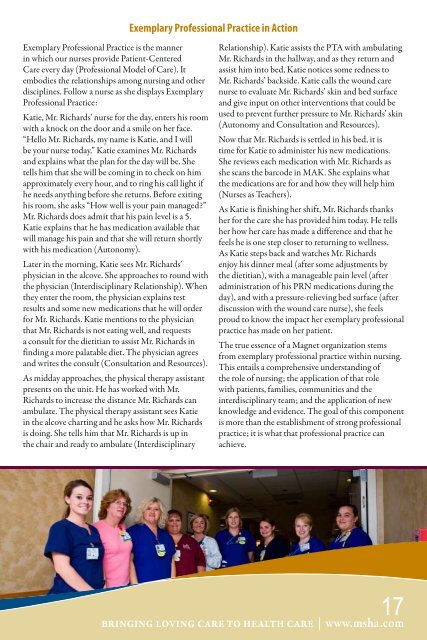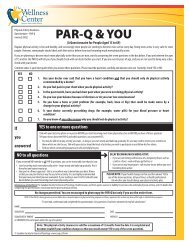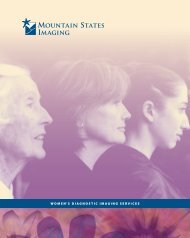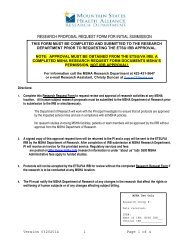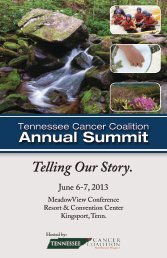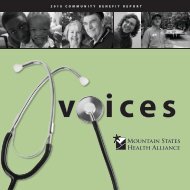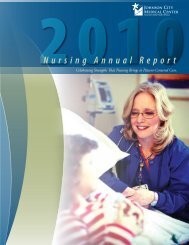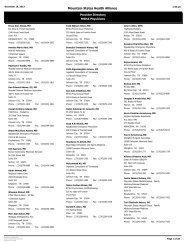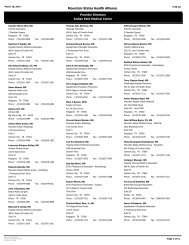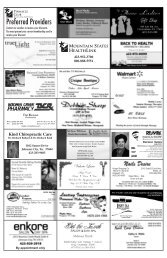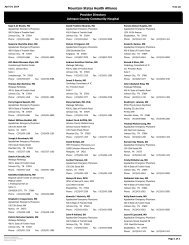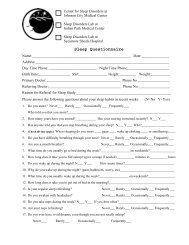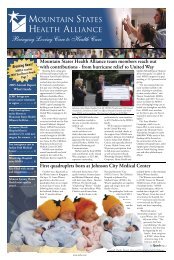JCMC Nursing Annual Report - Mountain States Health Alliance
JCMC Nursing Annual Report - Mountain States Health Alliance
JCMC Nursing Annual Report - Mountain States Health Alliance
Create successful ePaper yourself
Turn your PDF publications into a flip-book with our unique Google optimized e-Paper software.
Exemplary Professional Practice in Action<br />
Exemplary Professional Practice is the manner<br />
in which our nurses provide Patient-Centered<br />
Care every day (Professional Model of Care). It<br />
embodies the relationships among nursing and other<br />
disciplines. Follow a nurse as she displays Exemplary<br />
Professional Practice:<br />
Katie, Mr. Richards’ nurse for the day, enters his room<br />
with a knock on the door and a smile on her face.<br />
“Hello Mr. Richards, my name is Katie, and I will<br />
be your nurse today.” Katie examines Mr. Richards<br />
and explains what the plan for the day will be. She<br />
tells him that she will be coming in to check on him<br />
approximately every hour, and to ring his call light if<br />
he needs anything before she returns. Before exiting<br />
his room, she asks “How well is your pain managed?”<br />
Mr. Richards does admit that his pain level is a 5.<br />
Katie explains that he has medication available that<br />
will manage his pain and that she will return shortly<br />
with his medication (Autonomy).<br />
Later in the morning, Katie sees Mr. Richards’<br />
physician in the alcove. She approaches to round with<br />
the physician (Interdisciplinary Relationship). When<br />
they enter the room, the physician explains test<br />
results and some new medications that he will order<br />
for Mr. Richards. Katie mentions to the physician<br />
that Mr. Richards is not eating well, and requests<br />
a consult for the dietitian to assist Mr. Richards in<br />
finding a more palatable diet. The physician agrees<br />
and writes the consult (Consultation and Resources).<br />
As midday approaches, the physical therapy assistant<br />
presents on the unit. He has worked with Mr.<br />
Richards to increase the distance Mr. Richards can<br />
ambulate. The physical therapy assistant sees Katie<br />
in the alcove charting and he asks how Mr. Richards<br />
is doing. She tells him that Mr. Richards is up in<br />
the chair and ready to ambulate (Interdisciplinary<br />
Relationship). Katie assists the PTA with ambulating<br />
Mr. Richards in the hallway, and as they return and<br />
assist him into bed, Katie notices some redness to<br />
Mr. Richards’ backside. Katie calls the wound care<br />
nurse to evaluate Mr. Richards’ skin and bed surface<br />
and give input on other interventions that could be<br />
used to prevent further pressure to Mr. Richards’ skin<br />
(Autonomy and Consultation and Resources).<br />
Now that Mr. Richards is settled in his bed, it is<br />
time for Katie to administer his new medications.<br />
She reviews each medication with Mr. Richards as<br />
she scans the barcode in MAK. She explains what<br />
the medications are for and how they will help him<br />
(Nurses as Teachers).<br />
As Katie is finishing her shift, Mr. Richards thanks<br />
her for the care she has provided him today. He tells<br />
her how her care has made a difference and that he<br />
feels he is one step closer to returning to wellness.<br />
As Katie steps back and watches Mr. Richards<br />
enjoy his dinner meal (after some adjustments by<br />
the dietitian), with a manageable pain level (after<br />
administration of his PRN medications during the<br />
day), and with a pressure-relieving bed surface (after<br />
discussion with the wound care nurse), she feels<br />
proud to know the impact her exemplary professional<br />
practice has made on her patient.<br />
The true essence of a Magnet organization stems<br />
from exemplary professional practice within nursing.<br />
This entails a comprehensive understanding of<br />
the role of nursing; the application of that role<br />
with patients, families, communities and the<br />
interdisciplinary team; and the application of new<br />
knowledge and evidence. The goal of this component<br />
is more than the establishment of strong professional<br />
practice; it is what that professional practice can<br />
achieve.<br />
17<br />
bringing loving care to health care | www.msha.com


